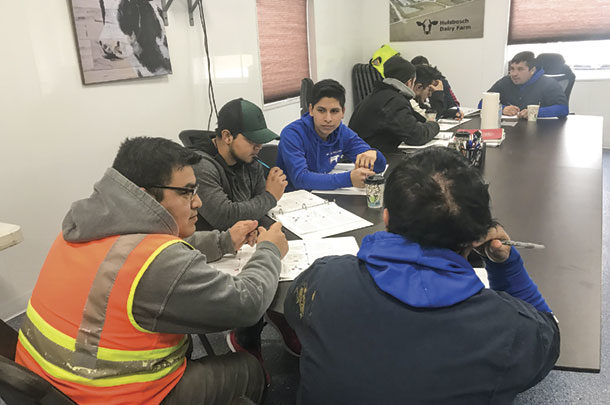For many years, our consulting group has been blessed to get to know and consult with many dairies and their leaders in our industry.
For the last two decades, we have been helping these leaders transition from the technical side of running an operation into the human resource side. We have had the opportunity to observe throughout the years how leadership greatly impacts employee engagement.
It does not matter the size of the operation – big, medium or small – if you are a “good leader,” employees will stay longer and will feel passionate about their contributions to the team. But if you are not, frustrations and struggles to get results will describe your daily reality.
In this article, we would like to dive deeper into how leadership impacts employee engagement. We also will share our experiences on how you can have a more engaged workforce of collaborators. After all, it is the direct responsibility of a leader to have an engaged team.
What is leadership?
Everyone knows what leadership is. We can talk about it in general terms. We know how good leadership should look and make us feel in general, but when we pop the question to a dairy owner or manager about what leadership means on your farm and to your employees, we see an awkward pause. Plus, every time we get a different answer. For some, leadership is a simple word: respect, hard work, trust or humility. Others come up with “getting things done” or “setting the example” or “achieving goals.”
When we talk about leadership with partners or managers in our seminars and classes, we define it as: “The attitude and ability that a person has to inspire, motivate, influence and guide others or a team to achieve common objectives or goals. Leadership is action, not a job position.”
Regardless of what your definition is, you must be sure all of your team members understand it and are able to execute it.
What is employee engagement?
In this article, it is important for us to share our definition of employee engagement. Any of us can identify a team that is “engaged.” Furthermore, we can identify which team members are completely engaged and which ones are not. Also, we can identify some collaborators on the team that we might say are “just kind of engaged.”
Often, employee engagement is confused with “job satisfaction,” but employee engagement goes much deeper than how content employees are. Many institutions have done research about it, and results have shown a direct correlation between how engaged your employees are and key performance metrics like profitability, employee retention, productivity, etc.
In our case, we define employee engagement as what happens when an employee connects rationally and emotionally with the employer.
Engaged employees feel the operation is their own, feel passionate about their contribution to it and have the utmost respect and appreciation for their leaders. Engaged employees don’t do just enough to collect a check; they go the extra mile day in and day out under unforgiving weather conditions.
Research shows that leadership (and its actions) are directly responsible for employee engagement in any organization.
How many of your employees are engaged?
Among U.S. agricultural workers, just 2 employees out of every 10 are engaged, while 2 are actively disengaged, according to Gallup. Actively disengaged employees are more or less out to damage their company. These types of employees have more on-the-job accidents, exhibit negative attitude, miss more days, show more frustration and are unhappy.
Think about your dairy’s team members: How many are engaged? How many just do the minimum required (not engaged)? How many are actively disengaged? Don’t worry if not many of your employees are engaged; you are not alone. We know that all operations have challenges regarding employees being engaged. We all need to have a higher percentage of employees engaged during these challenging times.
Every owner and manager we have met would love to have 50% of their team members consistently engaged. Research shows us that leadership and its actions – across all industries – have a tremendous impact on employee engagement. Out of 10 employees that leave a company voluntarily in the U.S., 7.5 leave because of their supervisors. It’s that simple.
Some actions leadership should take to improve employee engagement
There are two words we like to use when we are interacting with leaders: intention and deliberate. It is key that leaders act with clear, defined intention and in a deliberate way.
Here are several actions you can as a leader take to improve employee engagement:
1. Develop your culture intentionally
You must define your company’s core values and explain them to all of your team members. Develop a plan for achievement that all employees are aware of from day one that includes the core values of your operation. Execution using the core values is key.
Please keep in mind that every operation has a culture – whether it has been deliberately designed or left to chance. A culture of excellence starts at the top of the organization and is passed down.
2. Choose the right leader
The most common mistake we have seen made over the years in dairy operations we have had the opportunity to visit is that team members are being promoted to leadership positions mainly because they possess the technical skills to perform the tasks required by their departments. These high-performance individuals have shown over a period of time they are consistent and reliable. But what we are forgetting to take into consideration when promoting team members is how they can relate and engage with their peers.
Poor managers often know the ins and outs of every task in their department. They know what to do in case of an emergency, they know all the contingency plans, they know how to plan, how to organize, etc., but they have no people skills and don’t care about their team members’ safety and welfare. They don’t focus on developing their team; they just focus on processes.
3. Provide top-quality training
“The only thing worse than training employees and losing them is not training them and keeping them.” —Zig Ziglar
For every department in your operation, it is key to develop a top-quality training program for all technical aspects. We suggest having a trainer in every department. The more your employees know about milk quality, parturition, etc., the better they will be equipped to make the appropriate decisions on their own. Top training programs increase confidence, competence, productivity and efficiency.
A few notes on training:
- Trainers within your organization must be passionate and reflect the operation’s culture and values.
- Explain the role and contributions of the trainee in the organization.
- Point out desired behaviors.
- Always give feedback on trainees’ progress.
- Regarding technology, you must assess the literacy and needs of the trainee.
Additionally, you must invest in leadership programs if you want your leaders to step up, motivate, inspire and guide their teams to achieve the goals proposed. Some of us were not born as natural leaders, and we need a specialist to help us uncover and finely tune the leader within us.
In summary, in today’s shrinking labor pool, if you would like to have an engaged workforce, which is the foundation for sustainable results, you must choose the right leaders who will model your operation’s culture, core values and desired behaviors. You also must develop a top-quality training program in each department, and your operation must have clearly defined its culture, core values and what leadership should look like.
Visit Talentum4 for more information.
References omitted but are available upon request by sending an email to an editor:
How to measure employee engagement
Take a moment and think about each of your employees. Which of the following three categories do you think each fits into?
Engaged
Engaged employees are those who are involved in, enthusiastic about and committed to their work and workplace. These types of employees are the ones we dream about hiring. They are problem solvers, show lots of initiative, are highly enthusiastic and bring a positive attitude to the job environment. Once they have achieved a goal, they actively try to reach the next level.
Not engaged
Not engaged employees will usually show up to work and contribute the minimum required. These types of employees just try to kill time; they are not as disruptive as actively disengaged employees, but they often put up excuses like “That’s not part of my job”. Lastly, they do not show concern for achieving the team’s goals.
Actively disengaged
Actively disengaged employees are more or less out to damage their company. These types of employees have more on-the-job accidents, exhibit negative attitude, miss more days, show more frustration and are unhappy. The behavior they exhibit goes against the company’s values and mission statement.








